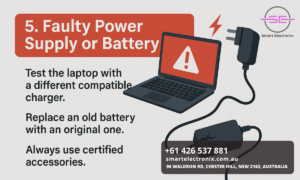
Ever been in the middle of an important Zoom call, school project, or gaming session only to have your laptop suddenly restart for no reason? Yeah, it’s frustrating. At Smart Electronix, we often hear from customers facing this exact issue. The good news? You’re not alone, and more importantly, there are real solutions.
Whether you’re using a Windows or macOS device, random laptop restarts can point to deeper problems. Understanding the possible causes and knowing how to fix them can save you money, time, and a whole lot of stress. In this guide, we’ll explore the common reasons behind unexpected restarts and how you can troubleshoot them without being a tech wizard.
1. Overheating Problems
One of the most frequent reasons for sudden restarts is overheating. When your CPU or GPU gets too hot, your laptop automatically shuts down or restarts to prevent internal damage. This usually happens when dust builds up inside your system or your cooling fan fails to function properly.
Fix:
- Ensure proper ventilation by not placing the laptop on soft surfaces like beds or pillows.
- Use a cooling pad for better air circulation.
- Get your laptop cleaned professionally at least once a year.
2. Faulty RAM
Bad memory modules can cause your laptop to act up. If your RAM is failing, it might trigger spontaneous restarts, system crashes, or blue screens.
Fix:
- Run the Windows Memory Diagnostic Tool or use MemTest86.
- If errors are found, replace the faulty RAM stick.
3. Outdated or Corrupt Drivers
Your hardware drivers play a key role in keeping your system running smoothly. When they’re outdated, corrupted, or incompatible with your system updates, random restarts can occur.
Fix:
- Update drivers using the Device Manager or manufacturer’s website.
- Use driver updater tools if you’re not confident doing it manually.
4. Malware or Virus Attacks
A compromised system might restart repeatedly due to malicious software. Viruses can modify core files, overload system memory, or trigger forced restarts.
Fix:
- Install reliable antivirus software.
- Run full system scans regularly.
- Remove suspicious files or apps immediately.
5. Faulty Power Supply or Battery
 A damaged battery or charger can lead to power instability. If your power source isn’t consistent, the system may shut down or reboot to protect hardware components.
A damaged battery or charger can lead to power instability. If your power source isn’t consistent, the system may shut down or reboot to protect hardware components.
Fix:
- Test the laptop with a different compatible charger.
- Replace an old battery with an original one.
- Always use certified accessories.
6. System Updates Gone Wrong
Sometimes, a recent system update or Windows patch may not install properly, causing software instability.
Fix:
- Roll back to a previous system restore point.
- Reinstall the operating system if the issue persists.
7. BIOS Issues
The Basic Input/Output System (BIOS) controls startup and hardware communication. Incorrect settings or outdated BIOS firmware can result in endless restart loops.
Fix:
- Reset BIOS to default settings.
- Update the BIOS, but only if you know what you’re doing—it’s risky!
8. Software Conflicts
Conflicts between installed software can sometimes cause crashes and restarts. Apps that demand high system resources or clash with system settings can be troublemakers.
Fix:
- Uninstall newly installed or suspicious apps.
- Perform a clean boot to isolate problematic software.
Prevention Tips from Smart Electronix
To keep your system healthy and avoid future restarts:
- Schedule regular system maintenance.
- Clean your device internally and externally.
- Use quality accessories like surge protectors and cooling stands.
- Always install updates from trusted sources.
When to Visit Smart Electronix
 If you’ve tried everything and the restarts continue, it might be time for expert help. At Smart Electronix, our technicians offer diagnostic services, hardware inspections, and repair solutions tailored to your needs. Whether it’s a minor software glitch or a serious motherboard issue, we can help get your laptop back in perfect shape.
If you’ve tried everything and the restarts continue, it might be time for expert help. At Smart Electronix, our technicians offer diagnostic services, hardware inspections, and repair solutions tailored to your needs. Whether it’s a minor software glitch or a serious motherboard issue, we can help get your laptop back in perfect shape.
Final Thoughts
A laptop that restarts randomly isn’t just annoying—it can interrupt work, cost you important data, and even indicate major hardware failures. By following the tips above and keeping your system in check, you can often resolve the problem before it worsens. For more support, trust the team at Smart Electronix to guide you through the right fixes.
Stay cool, stay updated, and if in doubt—we’re here to help!
